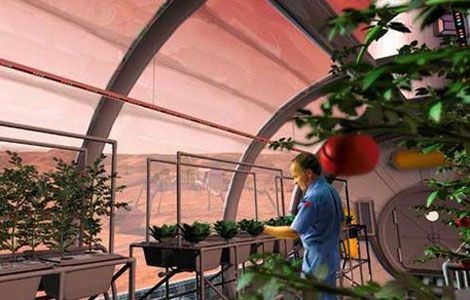When the Nearest Help is 34 Million Miles Away
A trip to Mars will be the riskiest journey we’ve ever attempted.
Deep space radiation is another serious concern; while it's possible that the spacecraft could be encased in a protective shield of water or liquid hydrogen, those technologies are very heavy, "and flight is all about reducing the weight," says Launius. It's possible that astronauts might be able to take drugs that would repair the DNA damage caused by radiation.
For a long-duration space flight, you need to give crews interesting and challenging work, says Apollo astronaut Ed Gibson. Ask Mike López-Alegría, who has spent 215 days aboard the International Space Station. "A lot of people say, well, seven months, you know, weren't you going stir-crazy? And I have to say that [an ISS] mission is not like that at all. There was always something to do, and the seven months went by very quickly."
The risks haven't stopped thousands from signing up with the Mars One project for a one-way trip. And the professionals aren't immune, either: Says astronaut Mike Fincke, "It would be an incredible adventure. It's a very important trip. It'll take a long time, I'd miss my family, I'd be fried by radiation, but I'd still take that trip."
The dreaded "red-eyed pumpkin head" (the result of bodily fluid shifts), deep space radiation, and a (literally) shrinking heart are just some of the risks humans will face when journeying 34 million miles to Mars. These hazards, and more, are outlined in the Smithsonian Channel's newest episode of Space Voyages: Surviving the Void, which premieres tonight, Monday, January 13, at 8 p.m. (EST), and will be shown again on Thursday, January 16, at 9 p.m.
Surviving the Void focuses on NASA's efforts to send humans to Mars—and beyond. "There is a 100 percent certainty that at some future time, this planet will be uninhabitable," says Roger Launius, a curator with the National Air and Space Museum. "The reality is we can build the technologies that we need to go to other places, but the human body itself is the most fragile of any of these technologies."
The episode examines just a few hurdles included in a three-year trip to the Red Planet, including food production. Skylab 4 commander Gerald Carr remembers the extensive menu for their more than 80-day mission. "We had three types of food," recalled Carr. "We had frozen food [including] filet mignon, lobster newberg, roast pork and dressing. The second type of food was freeze-dried, [similar to] camping food. The third type of food we had was canned food. NASA had a fancy term—they called it "thermal stabilized," but it was just plain old canned food, and most of that was our fruits."
But for the long trip to Mars, each astronaut would require more than 4,000 pounds of food. Michele Perchenok, an advanced food technology scientist at NASA, explains in the episode that astronauts won't be able to carry all of their nutrition with them, and will have to grow some of their own food on board, and once they arrive on Mars, as well.
